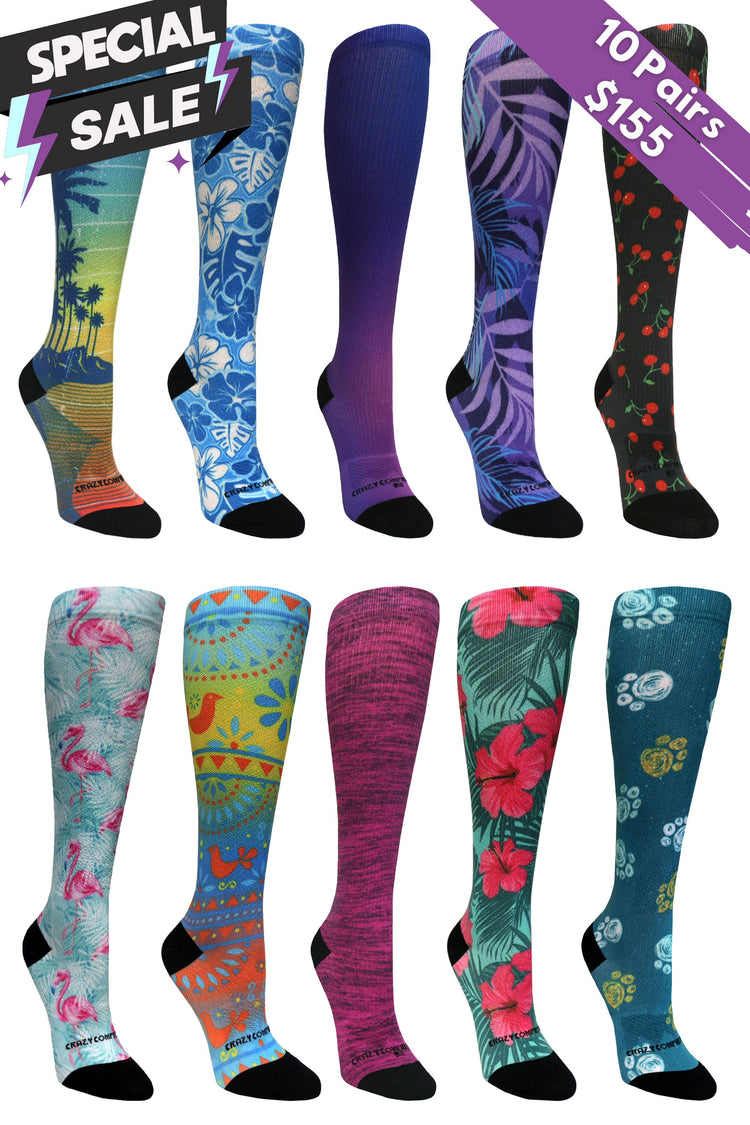Diabetes is a chronic health condition that affects over 34 million Americans. It occurs when your pancreas can't produce enough insulin to control your blood sugar levels, leading to heart, kidney, and vision problems. There isn't a cure for diabetes, but there are ways to manage it, including healthy weight loss, a balanced diet, an active lifestyle, and medication. Another great way to make your diabetes more manageable is to wear compression socks, especially if you experience lots of swelling in your legs.
Before we talk about the benefits that compression socks can have for people with diabetes, it is imperative that diabetics speak to a healthcare professional before trying any pair of compression socks. Your physician will be able to tell you which socks would be best for your unique condition, and they'll also be able to walk you through all of the potential health risks that are involved. Again: if you have diabetes, do not buy or wear a pair of compression socks without the expressed permission of your doctor.
Compression socks come in a lot of different pressures and lengths, which is another reason why talking to your doctor before trying a pair can be helpful. There is no "one fits all" in the world of compression, and your doctor will be able to tell you what length and which pressure would be most beneficial for your particular situation.
How Compression Socks Can Help DiabeticsWhen you have diabetes, maintaining your health is time-consuming enough without having to worry about your feet. Compression socks take a lot of potentially harmful health conditions off your plate so that you can focus on managing your other symptoms, as well as cultivating a new, healthy lifestyle. Some of the amazing benefits that compression socks can have for people with diabetes include reduced swelling, reduced risk of blood clots, reduced numbness, and reduced risk of skin infections.
Reduced SwellingA lot of people with diabetes struggle with peripheral edema, which is leg swelling caused by the retention of fluid. This swelling commonly occurs after a leg or foot injury, especially because people with diabetes have circulation problems that can prevent injuries from healing completely. Compression socks are specifically built to help reduce swelling in the leg by promoting better blood circulation from your feet to your heart. They do so by applying pressure at the ankle and then up the calf, keeping the blood moving and preventing fluid retention from occurring in the first place. Diabetics aren't the only people who can enjoy this benefit, though; people who spend all day standing on their feet or sitting at their desks can experience peripheral edema, which is why compression socks are so popular with nurses, doctors, and office workers. No matter what job you have, when you have a long day of work ahead of you, the last thing you need to worry about is soreness and swelling in your legs.
Reduced Risk of Blood ClotsDiabetics are also at a higher risk for Deep Vein Thrombosis (DVT), which is basically a blood clot in a "deep vein"--most often in the leg. While people with DVT may experience pain or swelling, they also may not have any symptoms at all. DVT can lead to a long-term condition called post-thrombotic syndrome (PTS), which causes problems with mobility, but it can also cause a pulmonary embolism (PE), which is when a blood clot becomes trapped in one or more arteries of the lung. Pulmonary embolisms can be potentially fatal, so it's important to take as many preventative measures as possible. Wearing compression socks, and promoting proper blood flow, will prevent DVT by keeping the blood in your legs from becoming too thick and forming a clot that could flow to your heart or lungs.
Reduced NumbnessNumbness in the extremities is another common symptom in people with diabetes; high blood sugar that remains uncontrolled over a long period of time can cause diabetic neuropathy, a type of nerve damage that's unique to people with diabetes. Though the exact way that blood sugar relates to nerve damage is unknown, it is possible that when blood sugar remains too high over an extended period of time, it can weaken the capillaries that supply nerves in the legs with oxygen and other nutrients. Compression socks can't fix the root of diabetic neuropathy since it's a condition ultimately dependent on a person's blood sugar levels, but compression socks can help you maintain feeling in your feet and toes thanks to the way they encourage proper blood circulation between your feet and heart.
Reduced Skin Infections and Infected WoundsWe've already discussed the way that neuropathy causes numbness in the diabetic's feet and legs. Because some diabetics experience numbness, it's harder for them to notice any scratches, cuts, or infections on the foot. One little cut that goes unnoticed can come into contact with all kinds of harmful bacterias and materials without the diabetic ever being the wiser, and the consistent, irritating rub of regular cotton material can cause infections to arise. Additionally, regular cotton socks absorb moisture and leave the wearer more at risk for bacterial infections whether there's already a cut or not. Compression socks, on the other hand, are made from a breathable, moisture-wicking material, so it does a lot of the work FOR you. Whether you decide to wear compression socks or not, though, if you have diabetes, it's important that you daily check your feet to make sure that you don't have any wounds that could become problematic.
When Diabetics Should NOT Wear Compression SocksIf you've been diagnosed with any kind of arterial disease, you should not wear compression socks. While they help promote better blood flow in most people, they may actually hinder proper blood flow in people with arterial insufficiency. One of these artery-related conditions is peripheral artery disease (PAD). If you have PAD, you have narrowed blood vessels, and wearing compression socks could restrict blood flow instead of improving it. Like we mentioned at the beginning of the article: it's always better to be safe than sorry. If you have diabetes, talk to your doctor about compression socks before you buy a pair.
We hope this information has been helpful for you. Living with diabetes is tough, but you're tougher. Make an appointment with your healthcare professional to see what compression socks can do for you!

































Leave a comment
This site is protected by hCaptcha and the hCaptcha Privacy Policy and Terms of Service apply.